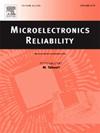RHBD current-mode bandgap with SET isolation using PVT-independent sensors
IF 1.9
4区 工程技术
Q3 ENGINEERING, ELECTRICAL & ELECTRONIC
引用次数: 0
Abstract
This manuscript introduces a single event transient (SET) detecting circuit which is used in a current- mode bandgap reference circuit to reduce the magnitude of SET-induced voltage pulses at the bandgap output. Switches controlled by the SET detectors are inserted between the bandgap and output. When either a positive or negative voltage transient is detected at bandgap, one of the switches will be turned off to temporarily isolate the bandgap circuit from the output, thus preventing the SET glitches from propagating to the load devices. A capacitor at the output was used to keep the output voltage stable in case of an SET. Once the collected charge is dissipated and the bandgap reference circuit resumes normal operation, the switches will be turned on so that normal reference voltage will be reconnected to the output. This proposed structure was fabricated in a 28-nm FDSOI technology. Simulated results revealed a significant reduction in the SET magnitude. These results were also validated experimentally by using a 105 MeV proton radiation facility, and the SET magnitude at the bandgap reference output can be limited to 10 mV. The implemented SET detector is a versatile structure that can be applicable to DC circuits including LDOs, DC-DC converters and other types of bandgap reference circuits, enhancing their reliability when operating in high radiation environments.
RHBD电流模式带隙与使用pvt独立传感器的SET隔离
本文介绍了一种用于电流型带隙参考电路的单事件暂态(SET)检测电路,用于降低带隙输出端SET感应电压脉冲的幅度。在带隙和输出之间插入由SET探测器控制的开关。当在带隙处检测到正电压或负电压瞬态时,其中一个开关将关闭以暂时隔离带隙电路与输出,从而防止SET故障传播到负载设备。在发生SET时,在输出端使用电容器保持输出电压稳定。一旦收集的电荷被耗散,带隙参考电路恢复正常工作,开关将被打开,使正常的参考电压将重新连接到输出。该结构采用28纳米FDSOI技术制备。模拟结果显示SET幅度显著降低。这些结果也在105 MeV质子辐射设备上得到了实验验证,带隙参考输出处的SET量级可以限制在10 mV。所实现的SET探测器是一种通用结构,可适用于直流电路,包括ldo、DC-DC转换器和其他类型的带隙参考电路,增强其在高辐射环境下工作时的可靠性。
本文章由计算机程序翻译,如有差异,请以英文原文为准。
求助全文
约1分钟内获得全文
求助全文
来源期刊

Microelectronics Reliability
工程技术-工程:电子与电气
CiteScore
3.30
自引率
12.50%
发文量
342
审稿时长
68 days
期刊介绍:
Microelectronics Reliability, is dedicated to disseminating the latest research results and related information on the reliability of microelectronic devices, circuits and systems, from materials, process and manufacturing, to design, testing and operation. The coverage of the journal includes the following topics: measurement, understanding and analysis; evaluation and prediction; modelling and simulation; methodologies and mitigation. Papers which combine reliability with other important areas of microelectronics engineering, such as design, fabrication, integration, testing, and field operation will also be welcome, and practical papers reporting case studies in the field and specific application domains are particularly encouraged.
Most accepted papers will be published as Research Papers, describing significant advances and completed work. Papers reviewing important developing topics of general interest may be accepted for publication as Review Papers. Urgent communications of a more preliminary nature and short reports on completed practical work of current interest may be considered for publication as Research Notes. All contributions are subject to peer review by leading experts in the field.
 求助内容:
求助内容: 应助结果提醒方式:
应助结果提醒方式:


